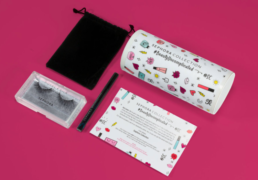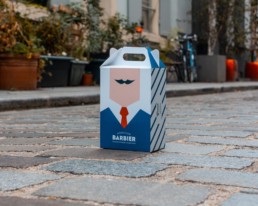Developing Promotional Kits: 5 Tips For Success
boxing
We’ve all heard the expression “thinking outside the box” so often, it’s become something of a cliche. But what about rethinking the box itself? When your marketing team is developing promotional kits for a client, it’s essential to think about what the brand hopes to accomplish by launching this kit, and to use the product’s strengths, selling points, and target audience to devise a fresh new way to reach a possibly already oversaturated market.
Today’s marketing departments face unique challenges that largely didn’t exist just a decade ago. While their predecessors were up to their eyeballs in decisions pertaining to TV, radio, and print media, present-day marketing professionals need to concern themselves with how their client’s product or service is received by a global audience connected via social media. Not only has our consumer base grown in numbers, but it has also grown in sophistication- people no longer want to feel as if they are being sold something, and instead are more drawn to story-driven narratives about a company’s founders, brand identity, or social consciousness. This authentic aspect helps drive sales, build brand loyalty, and raise the level of consumer awareness for a company, and must carry over from website to social media pages to email campaigns. By developing promotional kits, your marketing department can help make your brand’s story more three-dimensional and bring it to life by giving consumers an actual, physical thing they can touch and experience. The ability to hold something in your hand, to try it out and feel it, can help make more conversions than even the most polished SEO. In a digital world, it’s still important for companies to establish a physical connection between their products and their customers, and there’s no better place to start than with a well-developed promotional kit. Here are a few fundamentals for developing promotional kits that can help you turn even the most jaded consumers into an enthusiastic customer base.
What’s in the box? WHAT’S IN THE BOX???

The very nature of a promotional kit is to make someone excited about opening it! Think back to being handed a birthday present in your childhood: chances are the more beautifully the box was wrapped, the more you couldn’t wait to see what was inside. The same holds true for a promotional kit- the more creative the package, the more a consumer is likely to want to open it. By developing a promotional kit design that aligns with the identity of the brand and resonates with your target market, you are getting a lot of people interested in your product before they’ve even seen it.
Picture Perfect
OK, pop quiz- what’s the first thing people do these days when they are served a particularly exquisite meal? They whip out their mobile devices and photograph their dishes for social media, right? And once it’s posted, that’s free advertising for the restaurant that prepared the food. What if you could generate the same frenzied excitement responsible for restaurant food photography with your promotional kit? By getting exceptionally creative with packaging, your promotional kit could find itself featured on many an influencer’s Instagram feed. In fact, if you’ve got an impressive-enough promotional kit to warrant it, you could find your product featured in a YouTube unboxing video with over 1 million views, depending on who received it. That’s right- your promotional kit could wind up being slowly, lovingly taken out of its box by a high-profile YouTuber while 1 million people watch intently. It pays to create promotional kits that inspire that kind of large-scale intrigue!
Be Heard
A number of companies in today’s marketplace use their brand as a platform for speaking out about social, political, and environmental issues that are near to their hearts. A promotional kit can make a significant impact on a like-minded target audience by incorporating these views and ideals into its packaging strategy. Several quick-service restaurant concepts, for example, use inspirational quotes from famous people such as Gandhi, Rosa Parks, and Anne Frank, to decorate their paper bags, cups, and other consumables as a way to promote their products and their values simultaneously. By developing promotional kits with a message, a brand can be heard and seen at the same time, and build a following based on shared ideals and beliefs.
Take It Easy
Of course, when developing promotional kits for a brand, the goal is always to make the company stand out from the rest of their competition, but this does not necessarily mean the kit has to be overly complex. In fact, the more complicated the design of your promotional kit, and the harder it is to open, the more of a turnoff it can be for recipients- not just for the kit but potentially for the brand itself! It’s best to take a simple design concept and build on it from a creative standpoint. That way, your target audience will be able to appreciate the kit’s singularity without becoming frustrated while opening it!
Listen to Your Brand
As marketing professionals, it is your job to take a kernel of an idea and help it explode into a creative, memorable, and beloved concept. Products are helped along by the catchy slogans, engaging content, and exciting imagery that their advertising and marketing team comes up with, but not even the most awe-inspiring tagline will do a single thing unless it speaks to the brand’s already-existing values. For example, a fast-food burger joint markets a lot differently than, say, an investment firm, just because of how different the two products are. By staying tuned into your core audience, the nature of the product itself, and how the brand wishes to be represented, your team can develop a promotional kit that hits all the right notes!
The art of developing promotional kits is something that will continue to be highly valuable to a marketing firm, regardless of how much farther down the digital rabbit hole we go. People are always going to want an actual product sample they can try before they commit to a purchase, and by knowing exactly how to put together a killer promotional kit, your team will have a distinct advantage over competing brands who are putting out less exciting kits, or no kits at all, to consumers.
Looking for a solution? We can help.
Headquarters
9211 Corporate Blvd Ste 110
Rockville MD 20850
Satellite Offices
Dallas, TX
Paris, France
San Francisco, CA
Scottsdale, AZ
info@vivaboxsolutions.com
Phone
800-529-1988
Minimum Order Quantities:
RPET Totes: 3,000
Kraft Shoppers: 5,000
Rigid Boxes: 3,000
Folding Cartons: 5,000
The Top Five Benefits of Outsourcing Your Packaging Strategy
boxing
The outsourcing of branding and promotions to marketing agencies for a brand is not a new strategy. It has been a proven practice since agencies opened their doors. At the same time, there are branding strategies that are always changing, so there is a steady learning curve to keep up with. Competing brands and the ever-changing demands of consumers challenge in-house teams to stay on top with new trends while maintaining day-to-day work, and has created the perfect storm of requirements. Nowhere is this more recognized than with packaging.
Consumer demands for packaging change often, especially when they require seasonal designs, more versatile uses, product variety, convenience, GWP, a more eco approach, and product protection. Since packaging is as important as every other element of a brand (arguably a top 3 priority), these ever-changing demands impact every packaging brief, at least they should.
In-House Pain Points
As one of the only physical touchpoints consumers have with a brand, and as consumers grow more averse to talking to real people or asking for help in stores, packaging has become more relevant than ever. These trends have made it hard for in-house marketing departments (and those stand-alone marketing agencies) to keep up the juggling act. Packaging demands are simply changing too fast and becoming more prevalent in consumer purchasing decisions. Those demands are more than the logo, a brand voice, or attribute call-outs, this also means meeting packaging regulations, material, and shipping cost projections, and accessibility to the machinery that makes the packaging, not to mention the right assembly and quality controls and getting them delivered on time to the right distribution centers
Mental and financial resources are tight in business. Businesses may see the opportunity to design a new category or put a product in to fill a gap or new customer demand, but the company is not structured efficiently to capitalize. They might prefer to source the product directly, but there are no custom-ready solutions. It takes time and work to deliver a customized “only available at” product, but who has time to do that when executing the current business plan? There are frictions – working with brand standards, legal approvals, and logistics systems that are hard to navigate. In the end, it’s a great idea, but too complicated to execute.
Operational costs, space limitations, additional labor costs, and logistical planning are all financial and time-management expenses most businesses cannot afford to take on in-house.
The Benefits of Outsourcing
This is why outsourcing, especially with unique SKU development, custom packaging, seasonal packaging, and new product or loyalty kits, has become a must for a wide range of businesses to keep up with growing customer demand and stay ahead of the competition.
“A third-party product management (3PPM) provider is an extension of your business,” Vivabox COO, Peter Allen, said. “It manages anywhere from a single SKU to an entire product line of a company’s portfolio and executes product design, creative development, sourcing, manufacturing, and shipping into your distribution centers. You get to focus on the marketing and selling activities, and the rest is taken care of for you by the 3PPM.”
Allen has collaborated with several companies who struggle with in-house packaging. For most, the packaging is an animal they simply cannot tame because it requires several moving parts that cost time and money. When a packaging company is a 3PPM provider, the sole focus is building the best packaging solutions for the brand. It has the knowledge a packaging company should have, which allows companies to focus more on what they do best for their brand and leave the packaging logistics to the experts.
Here are the top 5 benefits companies experience when working with a 3PPM packaging provider, like Vivabox:
-
We help lower costs of product acquisition and design, and we can rapidly respond to changing trends in the industry.
-
We can help with a single SKU, or we can build entire categories for your brand.
-
We become an extension of your business, supporting you with account managers that learn how your business executes and tailors our process to meet your requirements.
-
We work with your teams—creative, marketing, finance, operations, and legal to make the process seamless—saving an average of 9 hours per person, per month involved in the project on the client-side
-
We align with your business and bring you expertise from outside and inside your category to help you see new opportunities.
If you find yourself in a position where you would greatly benefit from a 3PPM, but you are not sure where to begin, Vivabox Solutions can help. We have the capabilities to fill multiple roles in your business. We take concepts and bring them to life with creative strategies, all the way to building and delivering that product concept to you and serving it up for you to sell.
Learn more by contacting Vivabox.
Looking for a solution? We can help.
Headquarters
9211 Corporate Blvd Ste 110
Rockville MD 20850
Satellite Offices
Dallas, TX
Paris, France
San Francisco, CA
Scottsdale, AZ
info@vivaboxsolutions.com
Phone
800-529-1988
Minimum Order Quantities:
RPET Totes: 3,000
Kraft Shoppers: 5,000
Rigid Boxes: 3,000
Folding Cartons: 5,000
Using Customer Loyalty Programs in Retail
boxing
With the rise of big-box stores, online shopping giants, and same-day deliveries, the retail landscape has changed dramatically in a relatively short period of time. Consumers now have the freedom and flexibility to shop for virtually anything, any time of day, and enjoy affordable pricing, free shipping, and other perks that were once unheard of in the retail world. Because of this, the competition between retailers has never been more fierce. It is getting increasingly difficult to build and retain consumer loyalty with so many options available to shoppers nowadays. This seismic shift in how people purchase necessities and luxury items has caused a struggle among retailers to keep up with changing trends, as well as a constant search for a magic formula to stand out against competitors.

One of the most popular ways retailers maintain a healthy, thriving customer base is through loyalty programs. Many larger retailers offer customer loyalty programs that offer discounts and rewards earned through purchases. This strategy is effective not only by giving consumers an added incentive to do their business with a particular store, but also by ensuring that customers are likely to spend even more money when they return to use their reward points or earned discounts.
What Makes a Customer Loyalty Program Successful?
In order for a retail customer loyalty program to gain success among its target audience, it should meet the following requirements:
No Cost to Join
If a customer loyalty program is free, customers are far more likely to sign up than if there were a monthly or annual membership fee. While some retailers do offer rewards programs that cost money to subscribe, the free loyalty programs are almost universally more successful and popular than the ones that charge.
Keep in mind, however, that in order for a retailer to support a free rewards program, they must be able to cover the costs of the goods or services that are being given away or reduced in price. A prime example of this is the Starbucks rewards program, which is free to join and incredibly popular among its customers. Recently, customers could receive any menu item for free each time they earned 125 stars, at the rate of one star for each dollar spent in the store. Additionally, certain promotional events allowed customers to earn double or even triple stars on special days or at off-peak, “happy hour” times of the day. However, Starbucks recently had to change its reward redemption structure, as it became clear that customers were using their earned rewards stars toward big-ticket items, such as salads and sandwiches, rather than much-cheaper cups of coffee. The rewards program now operates on a tier system, but this has not seemed to hinder the success of the program.
User-Friendly
From the basic structure of the customer loyalty program to the ease and convenience with which points can be redeemed online, user experience is everything. When rolling out a new customer loyalty program, a retailer must make sure that both the desktop and mobile website or app supporting the earning and redemption of points is intuitive, convenient, and simple to use. Additionally, the structure of the program should be easy to understand and clearly laid out to avoid confusion and frustration among customers.
Not surprisingly, the Amazon Rewards Visa is one of the most user-friendly customer loyalty programs in existence. A digital native, Amazon has always led the pack when it comes to innovating online retail systems, and its rewards program is no exception. Though becoming a Rewards Visa member does require signing up and being approved for an Amazon credit card, after that, the reward points are as easy to redeem as they are to earn – both on and off the Amazon website. Even more importantly, members are able to access their point balance and view past transactions, earned reward points, and more on the website or mobile app, making it convenient, easy, and, as Amazon itself would say, “frustration-free.”
Great Incentives
As consumers everywhere can probably tell you, not all customer loyalty programs are created equal. Some retailers, for example, offer things like “store cash,” which can be redeemed only during select weeks and take a percentage off of a future purchase, rather than giving a customer anything for free. A good rewards program should offer a healthy balance of same-day discounts and the ability to redeem points toward free items. Some of our favorite incentives give the consumer a choice of special addition kits which make them feel rewarded while also introducing them to new products.
However, the ease with which customers can receive rewards is just as important as the incentives themselves. A number of customer loyalty programs tend to make people spend far too much before parting with even the smallest incentive on the tier. Movie theater rewards programs are a notorious offender, forcing rewards members to spend literal hundreds of dollars on ticket and concession purchases before even being granted a free small popcorn valued at five dollars!
No Expiration Date
A reward earned should be a reward kept. However, some retailers have structured their customer loyalty programs to include expiration dates for discounts and free items, even though a consumer has earned the points fair and square. The expiration date strategy is a purposeful one, designed to make customers come back sooner. However, it can be a major turnoff to earn enough points for a large reward, only to be told by a sales associate that those points expired one week ago! By structuring a customer loyalty program with no expiration dates, you are showing customers that you value them as people, not dollar signs.
Chick-Fil-A does a very nice job of handling the balance between when points are earned and when they are redeemed. Their loyalty program allows customers to spend their accumulated points either little by little or in one lump sum. A customer can use the Chick-Fil-A mobile app to easily keep track of how many points they have earned, as well as which free reward items are available to them. Once a customer redeems a reward, it becomes a coupon that is only available for 24 hours, but since most customers wait to redeem their reward points until they are already at the restaurant, this system does not cause confusion or frustration for anyone involved.
By keeping your customer loyalty program simple, free, and easy to use, you will be able to provide incentives that entice consumers to keep coming back to your retail store over and over again. Follow these guidelines when structuring your customer loyalty program and you will have a devoted customer base in no time. How can Vivabox help you create a successful loyalty program? Contact us to find out.
Looking for a solution? We can help.
Headquarters
9211 Corporate Blvd Ste 110
Rockville MD 20850
Satellite Offices
Dallas, TX
Paris, France
San Francisco, CA
Scottsdale, AZ
info@vivaboxsolutions.com
Phone
800-529-1988
Minimum Order Quantities:
RPET Totes: 3,000
Kraft Shoppers: 5,000
Rigid Boxes: 3,000
Folding Cartons: 5,000
In our Digital World, Your Packaging May be the Only Physical Connection You Have with Your Consumers. Three Ways to Make Sure it Counts.
boxing
The process of opening a new product can be a gift-like experience which embeds itself into the consumer’s psyche and can even be as great as the product itself.
Packaging is a visceral experience, and as our culture becomes continuously more visual, it feeds more than our desire for something to simply be a container. Our packaging has to mean as much as the product inside of it. Whether it has an aesthetic or ecological meaning, we want our packaging to be a reflection of us. There is a reason why brands rely on them so much. Without the right packaging, people will walk right by you, or even worse, not like you.
So here are three things to think about as you move forward with packaging ideas for the holidays and beyond:
1. The Outer Gift
In the best case scenario, we want our customers to be loyal, and packaging can build and maintain loyalty in a very tangible way. For example, think about a Tiffany box—many of us have never seen one in person, but if someone set one in front of us, it would take a lot to hold us back. There is an entire ethos surrounding that simple robin’s-egg-blue-and-white packaging, and it makes what is inside that much more coveted.
These experiences should be at the foreground of every brand’s identity, and packaging tugs at the very foundation of our consumer experience, whether we are aware of it or not.
According to Danielle Sauvé, Director of Customer Insights and Experience at Danaher Product Identification Platform, “Product packaging is often the only physical marketing channel that the consumer physically touches.”
So, customer loyalty is just as grounded in the tactile experience as it is in the visual and digital experience. Every detail is essential to address.
2. Seasonal Packaging
Adjusting packaging during holidays or other seasonal events is also a way to increase brand loyalty. If the packaging changes enough to be seasonal, customers appreciate the effort. However, be careful…adjusting for holidays or other events should only be taken so far. Customers still want to be able to identify the brand easily rather than hunting for it on a shelf.
Tasteful seasonal packaging is difficult to come by, so also think about how measured you want to be when implementing your packaging strategy. For example, as impressive as Christmas may be for many, the red and green combination can be a bit harsh or garish to others. Many who want to be more tastefully understated may go with more natural color combinations or interesting plaids.
3. The Inner Gift
Another layer of packaging that is just as important is the layout. How does it look once it is opened? As convenient as some packaging is, if each piece is bubble wrapped and jumbled in a box, the customer experience declines rapidly. One does not want to go from the elation of opening a beautiful box to cursing under their breath to unwrap multiple items in taped plastic. If the experience turns sour, you can bet that customer loyalty may as well.
Another common complaint is buying a product with the notion that the packaging is sustainable, only to get inside to find unrecyclable plastic materials. No one wants guilt wrapped with a bow.
So what does all of this mean for the brand? The consumer experience should be a pleasant one from the moment one starts looking for a product, through the unwrapping and big reveal, to the moment when they wonder whether they will keep the box or recycle it. It may be easier said than done for many businesses, but it is a necessity to think about every step of the buyer journey if you want to build and maintain consumer loyalty.
Looking for a solution? We can help.
Headquarters
9211 Corporate Blvd Ste 110
Rockville MD 20850
Satellite Offices
Dallas, TX
Paris, France
San Francisco, CA
Scottsdale, AZ
info@vivaboxsolutions.com
Phone
800-529-1988
Minimum Order Quantities:
RPET Totes: 3,000
Kraft Shoppers: 5,000
Rigid Boxes: 3,000
Folding Cartons: 5,000






